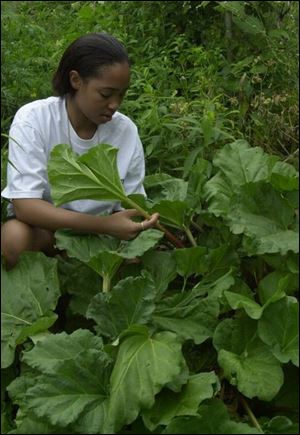
Stalk prolific rhubarb all summer long
6/26/2002Rheum rhabarbarum - kind of “rholls” off the tongue, don't you think? Cherry-red rhubarb is a perennial vegetable that can get mixed reviews once it hits the dinner table. Some people turn up their nose and say, “No thanks!” Others may have a faint memory of grandma's rhubarb marmalade and beg for seconds. Its stalk can be used to make pie filling, jam, jelly, sauce, and even rhubarb juice.
Rhubarb grows from a crown planted two to three inches below the soil surface. The plants grow best in well-drained soil with five to six hours of sun per day. After planting new crowns, let the plants have a few years to get a strong root system established. Don't harvest anything the first year, harvest only a small amount the second year, and, as long as the plants have been growing larger and healthier, pull all you want starting in the third year.
Only the stalk is edible. The large green leaves and roots contain oxalic acid, which is toxic.
The stalk turns reddish-green when it is ready to harvest. Rhubarb stalks are at their tastiest when they are 12-14 inches long and no wider than one inch. The peak months for rhubarb are May and June. If harvested often, the plant will keep producing new shoots until late summer.

Brittney Williams, educator assistant at Toledo Botanical Garden, harvests rhubarb in the Pioneer Garden.
To harvest, just hold the stalk near the ground and gently tug it off the crown. Don't cut the stalks. They will bleed and could invite bugs or cause the plant to rot. Leave the big leaves behind as mulch to smother pesky weeds in the rhubarb patch.
After a hot, dry spell, rhubarb may start to flower. You can still harvest the stalks even after the plant starts producing flowers. If you like the looks of its tall white blossoms, leave them on the plant. If you want rhubarb only to harvest the stalks, cut the flower growths as soon as you see them sprout. That will funnel the plant's energy back into producing more stalks, rather than working so hard to show off its flowers.
Even after a rhubarb patch has been hit with frost, the stalks still can be harvested. Look closely at the patch. If stalks look droopy, discolored, or mushy, don't eat them. The oxalic acid may have worked its way back into those stalks, and they could be toxic. After rhubarb has been pulled and chopped, it can be stored in a refrigerator for up to three weeks. You can also toss it in a freezer. You may need to adjust your recipe when using frozen rhubarb because freezing makes the vegetable much juicier when thawed. If your rhubarb patch starts to look thin and spindly, try dividing the crowns to rejuvenate it. A well-established rhubarb patch can keep growing for more than 50 years. It is an heirloom vegetable that can be transformed into sweet delight with one important ingredient - sugar. If you don't add enough, get ready to pucker up.